The ASRock DeskMini A300 Review: An Affordable DIY AMD Ryzen mini-PC
by Ganesh T S on April 26, 2019 8:00 AM ESTGPU Performance for Workstation Workloads - SPECviewperf 13
The SPECviewperf benchmark from SPEC provides an idea of the capabilities of the GPU in a workstation from the perspective of different CAD, content creation, and visual data analysis tools. It makes more sense to process these benchmarks on workstations with professional GPUs, but, consumer GPUs are often the choice for machines that need to handle both gaming and professional workloads. Since the Radeon RX Vega 11 performs admirably for an integrated GPU in our gaming tests, we wanted to give the DeskMini A300 a go with the SPECviewperf 13 workloads also.
SPECviewperf 13 includes nine different workloads representative of graphics content and behavior of actual applications. They make use of the OpenGL 4.0 and DirectX 12 APIs under Windows. SPECviewperf 13's workloads (termed viewsets) can officially be run only at two desktop resolutions (1920 x 1080, and 3840 x 2160), and need the display scaling to be set to 100% (DPI of 96). The available viewsets are listed below.
- 3ds Max (3dsmax-06)
- CATIA (catia-05)
- Creo (creo-02)
- Energy (energy-02)
- Maya (maya-05)
- Medical (medical-02)
- Showcase (showcase-02)
- Siemens NX (snx-03)
- Solidworks (sw-04)
The 3ds Max and Showcase viewsets are available only when processing at 1920 x 1080. The rest are available at both resolutions.
We processed SPECviewperf 13 at both resolutions on the ASRock DeskMini A300. The benchmark measures the frame rate at which the GPU renders the scenes in a viewset. Each viewset is composed of different scenes and rendering modes, and the composite score for the viewset is a weighted geometric mean of the FPS measured for the different scenes. In this section, we take a look at how its composite scores stack up against other systems targeting this market segment.
3ds Max (3dsmax-06)
The 3dsmax-06 viewset comprises of 11 different scenes. They have been created from traces of the graphics workload generated by Autodesk 3ds Max 2016 using the default Nitrous DX11 driver. Additional details are available here.
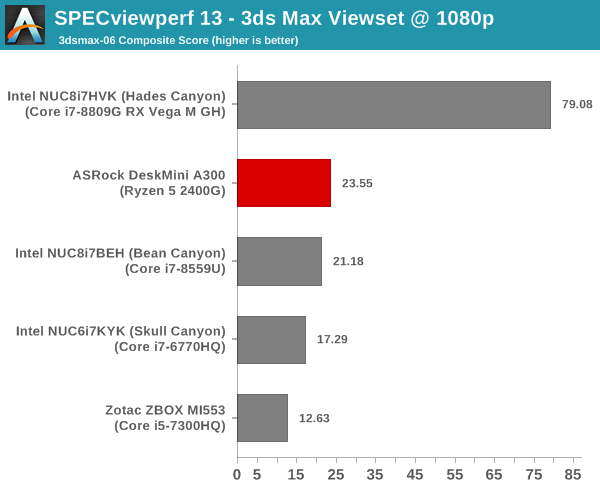
The DeskMini A300 is again the leading iGPU-only system, but, the Bean Canyon NUC's performance is quite close.
CATIA (catia-05)
The catia-05 viewset comprises of 14 different tests created from traces of the graphics workload generated by the CATIA V6 R2012 application from Dassault Systemes. Additional details are available here.
| SPECviewperf 13: CATIA Viewset Composite Scores | |||

The DeskMini A300 and the Bean Canyon NUC are essentially tied in this workload.
Creo (creo-02)
The creo-02 viewset comprises of 16 different tests created from traces of the graphics workload generated by the Creo 3 and Creo 4 applications from PTC. Additional details are available here.
| SPECviewperf 13: Creo Viewset Composite Scores | |||
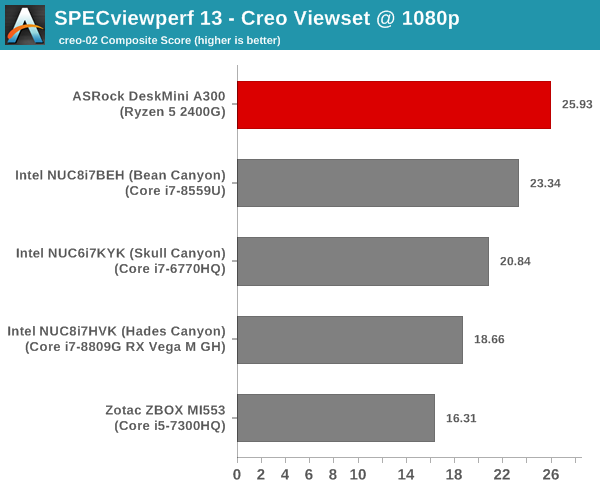
The Ryzen system is ahead at 1080p, but, falls slightly behind the Bean Canyon NUC at 2160p.
Energy (energy-02)
The energy-02 viewset comprises of 6 different tests based on techniques used by the OpendTect seismic visualization application. Additional details are available here.
| SPECviewperf 13: Energy Viewset Composite Scores | |
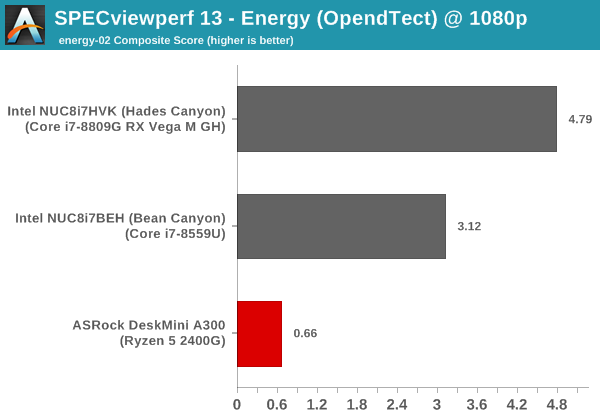
The energy-02 workload is a tough nut to crack for SFF systems, and the DeskMini A300 seems to have some trouble in completing the workload properly. At 2160p, all the systems that we are comparing the A300 against had trouble with the workload - hence, we do not have a graph for the workload at that resolution.
Maya (maya-05)
The maya-05 viewset comprises of 10 different tests based on traces of the graphics workload generated by Autodesk Maya 2017. Additional details are available here.
| SPECviewperf 13: Maya Viewset Composite Scores | |||
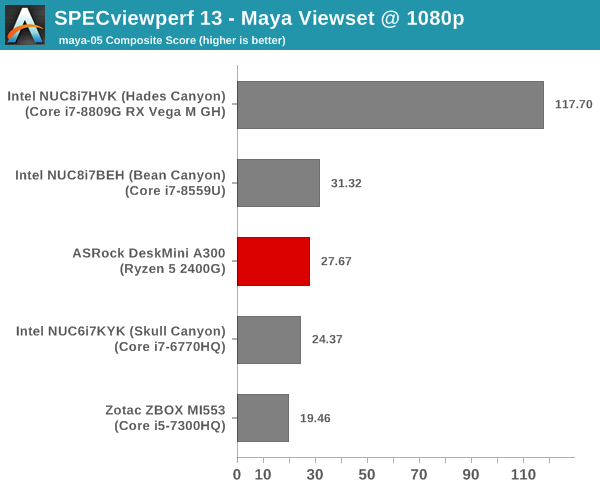
The Bean Canyon NUC edges ahead of the DeskMini A300 for the maya-05 workload at both resolutions.
Medical (medical-02)
The medical-02 viewset comprises of 8 different tests derived from 4 distinct datasets. Each test uses the ImageVis3D volume visualization program's Tuvok rendering core for 2D projections of 3D volumetric grids. Additional details are available here.
| SPECviewperf 13: Medical Viewset Composite Scores | |||
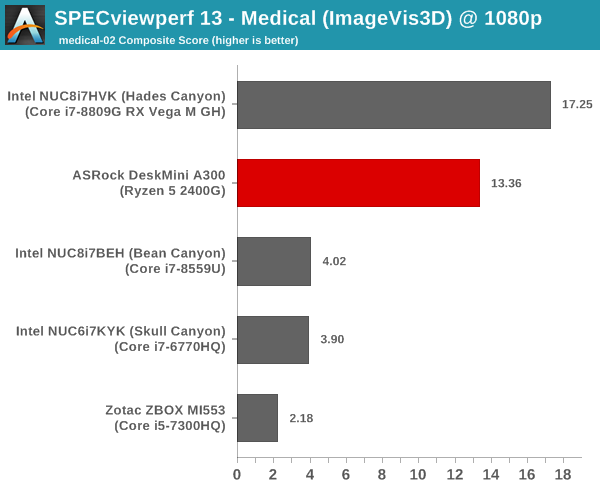
The medical-02 viewset represents a clear victory for the DeskMini A300 over other iGPU-only systems.
Showcase (showcase-02)
The showcase-02 viewset comprises of 4 tests created from traces of the Autodesk Showcase 2013 application rendering a racecar model with 8 million vertices using different modes. Additional details are available here.
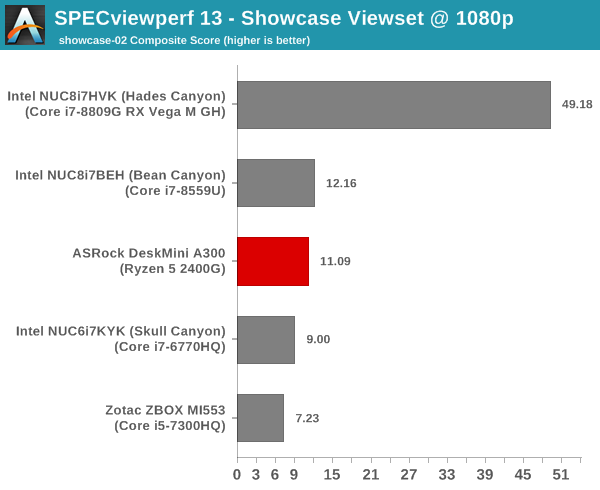
The showcase-02 viewset sees the Bean Canyon NUC edge slightly ahead of the DeskMini A300.
Siemens NX (snx-03)
The snx-03 viewset comprises of 10 tests created with traces from the graphics workload generated by the NX 8.0 application from Siemens PLM. Additional details are available here.
| SPECviewperf 13: Siemens NX Viewset Composite Scores | |||
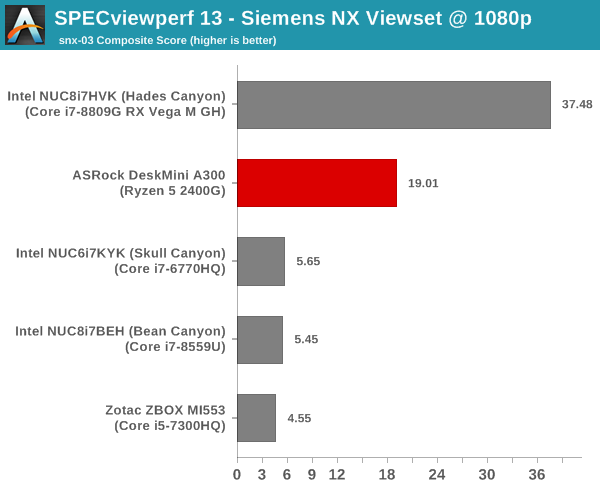
The snx-03 viewset is similar to the medical-02 viewset in terms of the DeskMini A300 enjoying a clear lead.
Solidworks (sw-04)
The sw-04 viewset comprises of 11 tests created from traces of Dassault Systemes’ SolidWorks 2013 SP1 application. Additional details are available here.
| SPECviewperf 13: Solidworks Viewset Composite Scores | |||
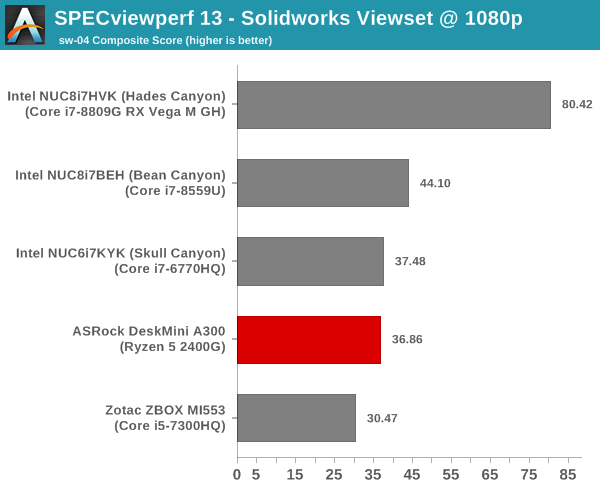
In this viewset, we see the Bean Canyon NUC come out on top, with the DeskMini A300 tussling it out with the Skull Canyon NUC for the second place amongst the iGPU-only systems.
Overall, for the SPECviewperf 13 workloads, we see that the DeskMini A300 is not a clear winner. There are a couple of viewsets in which the A300 performs significantly better, but, for the most part, the Bean Canyon NUC mounts an excellent challenge. The reasons for this could be two-fold - on one hand, the Radeon drivers for the RX Vega 11 might not be really optimized for these kinds of workloads. On the other, the Bean Canyon NUC employs an Iris Plus 655 GPU which comes with 128MB of eDRAM cache. It is likely that the eDRAM is beneficial for SPECviewperf 13 workloads.










88 Comments
View All Comments
Alexvrb - Saturday, April 27, 2019 - link
I just want to know if it supports cTDP, and if so, does it work well. Some boards do better than others.CharonPDX - Friday, April 26, 2019 - link
Now that "integrated graphics" are starting to reach actually-usable levels, I'd like to see VR added to these SFF reviews. We keep the Oculus Rift in the living room, but have to bring the "gaming PC" out every time we want to use it. I'd love to get a small "capable enough for basic VR games" PC to just live in the living room to run the Oculus.Relatedly, it mentions the DP, HDMI, and VGA ports - but does the front panel USB-C port allow video output via DisplayPort Alternate Mode? If it can play basic VR games acceptably (BeatSaber is the big one,) I'd rather use the front-panel USB-C with one of Accell's USB-C VR adapters.
GreenReaper - Friday, April 26, 2019 - link
It's "usable" up to 1080p on a single screen. Most VR systems use resolutions higher than this, one in each eye, and require twice the frame rates offered here. Don't get me wrong: I want this too, but if top-end Navi-based APUs *doubled* performance they'd still struggle, and they're a year away. Maybe if we had a dual-APU system? (Man, now I'm imagining this for a console.)piasabird - Friday, April 26, 2019 - link
I have the Intel 310 version of the Desk Mini. I think on your review it is too technical while not stressing the ease at which a 2.5 SSD can be installed. The Data/power connectors on the back of the motherboard make it fairly easy and with not much cable clutter. However, I found the cables were easier to connect if you remove the motherboard first. Since some people may want to use a 2.5 SSD, you should have tested that. I wish a similar design was available in Mini-ITX. However, it seems unavailable on the consumer level for the most modern CPU's like the one used in this review.mikato - Tuesday, April 30, 2019 - link
I completely agree. I don't think it was mentioned anywhere in the review that you can add a 2.5" drive - and you can actually add 2 x 2.5" drives according to the ASRock specs page. That sets it apart from other mini PCs significantly. Most only support 1 x 2.5" drive, or the thin NUCs don't support any. That gives you some solid storage options. You can actually forgo the media server and have both ends of the HTPC in one compact box (front-end with all streaming options, and the file storage for local media).sor - Friday, April 26, 2019 - link
I picked up two for my kids, with 2400Gs. Can’t beat the price. I have them mounted to the backs of their monitors which makes for a compact powerful all in one.I’ve got Ubuntu 19.04 on them and they run Dota2 like butter. Better than my 2018 MacBook Pro with discrete Radeon 560x.
My only ask might be two more rear USB ports, but it hasn’t been an issue so far.
sor - Friday, April 26, 2019 - link
Come on guys! The wraith cooler fits and is clearly superior to the boxed one.It may not be listed as supported dimensionally, but you just need to take the superficial ring off the fan and you can ease it in with a little care.
oliwek - Saturday, April 27, 2019 - link
Or just add a low profile Noctua cooler, it's dead silent even under full load, and you won't ever see (nowhere near) 80 degrees celsius as with the stock cooler!https://noctua.at/en/nh-l9a-am4
sor - Friday, April 26, 2019 - link
I just checked and I’m averaging about 57FPS on my 2400G deskmini A300w in 1080p, all settings max.That’s about 50% better performance than the review sees, which is huge. I am running Ubuntu 19.04 out of the box (no munching with drivers).
I AM using the wraith cooler as mentioned, which is also a difference. Are the windows drivers that bad? Or is it the cooler, or something else?
oliwek - Saturday, April 27, 2019 - link
The stock cooler is adequate for a 35watts athlon 200ge, but I'd avoid those high temps with 65W APUs we see here. I don't understand why not to mod the Wraith cooler as you chose to, as it's delivered with the processor, or else take an aftermarket low profile cooler (the Noctua looks like it was designed around this A300 motherboard).